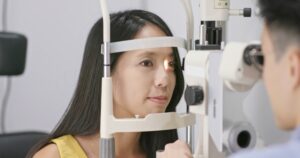

SMILE FAQs
What is the difference between SMILE vision correction and LASIK laser vision correction? Which one is better?
LASIK laser vision correction requires cutting a thin corneal slice (called a corneal flap) on the cornea to correct vision, so the incision is relatively large. SMILE Smile Vision Correction is a brand-new laser vision correction technology that only requires a small incision of 2-4 mm without opening the corneal flap, so the incision area is reduced by nearly 80%. Postoperative eye dryness and chances of infection are reduced, recovery time is also faster, and there is no problem of corneal flap displacement.
But there is a misunderstanding in the market. Many people think that SMILE is a new technology and must be better than LASIK. In fact, you need to choose the appropriate surgical method according to your personal situation. For example, if you have farsightedness or myopia is more than 1000 degrees, SMILE vision correction is not suitable.
Am I suitable for SMILE?
Most people are suitable candidates for SMILE laser vision correction, but a thorough examination by an ophthalmologist is necessary to confirm. Certain eye conditions—such as thin corneas, keratoconus, or severe dry eye—may otherwise go undetected.

Under what circumstances cannot SMILE be used for vision correction?
- Ocular development not yet complete
- Refraction not yet stable
- Cornea too thin/Keratoconus (requires corneal collagen cross-linking)
- Too high the refractive errors
- Hyperopia (Long-sightedness)
- Known eye disease (e.g. cataract, glaucoma)
- Infection of the eye
- Corneal scarring or other corneal disease
- Severe Dry Eye/ severe lack of tear production
- Herpes patient
- Immune system diseases (e.g. rheumatoid arthritis, lupus erythematosus)
- Long-term use of steroids
- During pregnancy/lactation
Am I suitable for SMILE if I have dry eye syndrome?
It is recommended to treat dry eye disease first, and if necessary, consult an ophthalmologist for professional care. You are also welcome to visit our Dry Eye Center, where we provide analysis and management for mild to severe cases. By combining the latest diagnostic technologies to identify the root causes of dry eye, we are among the first to adopt the most advanced and modern treatment methods.
If I am suitable for SMILE, can I arrange the correction immediately?
Before surgery, you need to undergo a comprehensive eye examination, including power test, corneal thickness and curvature test, etc., in order to use accurate data to formulate an appropriate vision correction plan. Before the first eye examination, the client needs to stop wearing contact lenses.
- Soft contact lenses (excluding astigmatism): stop wearing for at least one week
- Soft contact lenses (including astigmatism): stop wearing for at least two weeks
- Rigid contact lenses: stop wearing for at least one month
- Vision-correcting contact lenses: stop wearing for at least three months
The first examination and vision correction surgery can be performed on the same day at the earliest.
Will the vision correction surgery procedure be painful?
There will be local anesthesia in the eye before the vision correction surgery, so the client will not feel much. And the vision correction process is completed within 10 minutes.
Will I still have presbyopia after SMILE?
Presbyopia (age‑related farsightedness) may occur, as the tiny muscles that hold the lens usually begin to weaken after the age of 40, causing near vision to become blurry. SMILE laser vision correction can also help address presbyopia. For more details, please consult the ophthalmologists at iSsee Eye Centre.
How does SMILE correct presbyopia?
The Mono Vision solution can solve the problem of presbyopia. One eye is responsible for distance vision and the other eye is responsible for near vision. For example: one eye is corrected to close to zero degrees, while the other eye is left with 100-200 degrees of myopia.
Will recurrence occur after SMILE surgery?
Many people think that after vision correction, it is considered successful only when the eye diopter changes to zero. This is a misconception. The standard for successful rate of vision correction is within +/- 75 degrees. Now 90% of people are within +/-50 degrees, which will not affect their lives. If the degree exceeds a certain level and the patient feels that it affects their life, enhancement surgery can be performed.
Can I still undergo other eye surgeries after undergoing SMILE?
Yes, SMILE only changes the curvature of the cornea and will not affect other eye tissues.
Can it be done if the cornea is too thin? What is corneal collagen cross-linking surgery?
Yes, only additional corneal collagen cross-linking is required. This is suitable for patients whose corneas are too thin or degree too deep, and who are suspected to be at risk of potential cone cornea. The ophthalmologist will evaluate the client before surgery to determine whether additional corneal collagen cross-linking surgery is needed. Corneal collagen cross-linking involves applying riboflavin (a vitamin) eye solution to the patient's eyes, and then irradiating the eyes with ultraviolet light for 45 seconds to 1 minute to achieve corneal cross-linking and strengthen the cornea.

